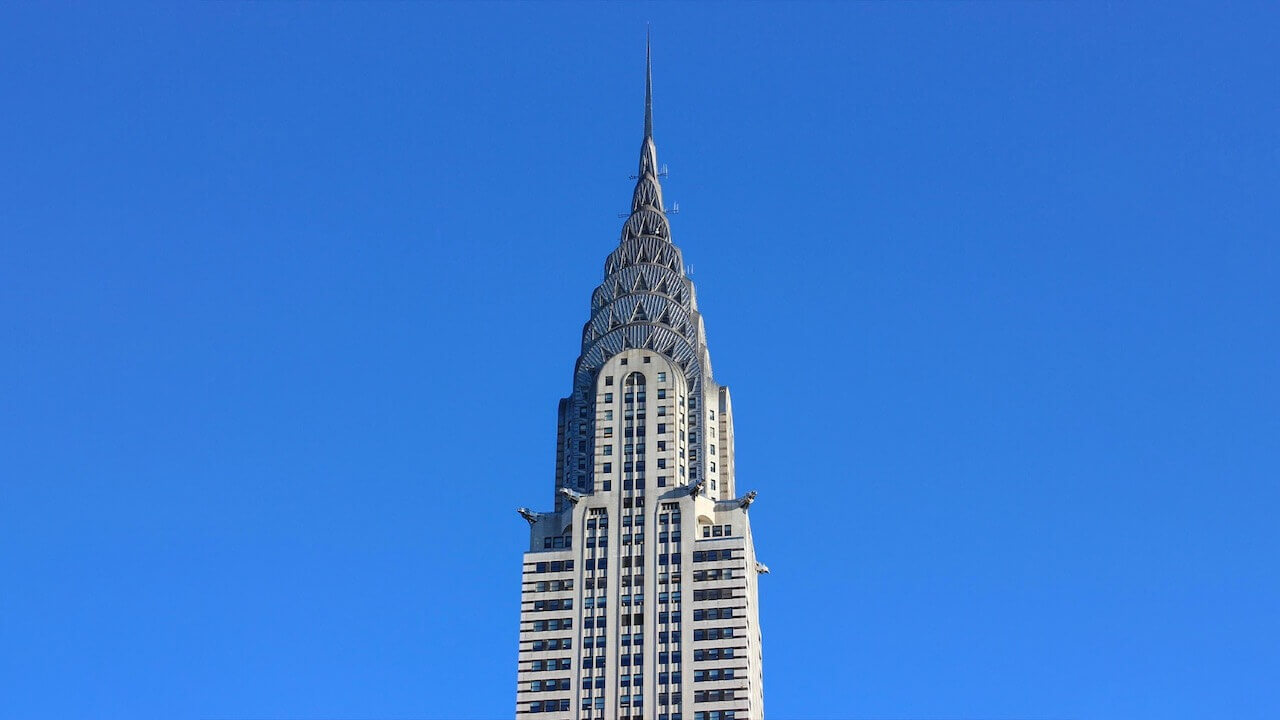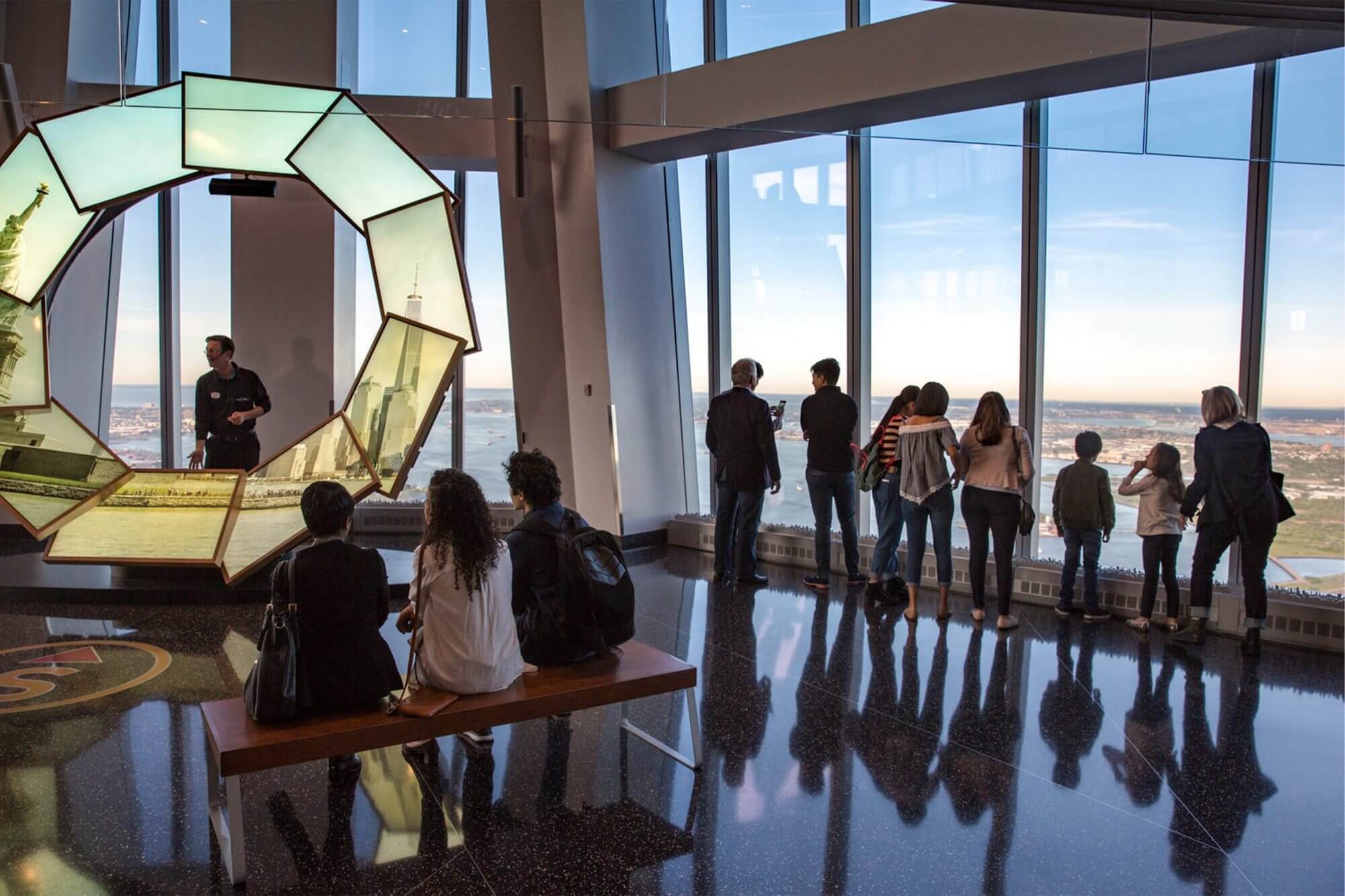North

PIER 40
The large pier attached to the Manhattan side of the Hudson River with the big square grass field in the middle is Pier 40. Part of the Hudson River Park, Pier 40 is a public recreational facility used by an estimated 200,000 children and adults annually. Steven Powers’s “I WANT TO THANK YOU” mural has been a fixture on the pier since October 2019. The mural was inspired by the history and artists of the surrounding neighborhood and pays tribute to The Global Fund and its fight against HIV/AIDS.
SULLY LANDING ZONE
On Jan. 15, 2009, a U.S. Airways airplane piloted by Chesley “Sully” Sullenberger hit a flock of migrating Canadian geese, disabling both of the plane’s engines. To avoid endangering people on the ground, Sullenberger and his co-pilot, Jeff Skiles, set the plane down in the Hudson River at West 48th Street — essentially, to the left of Midtown. Despite the emergency landing and the frigid air temperature — 20° Fahrenheit, or -7° Celsius — everyone survived.


THE EMPIRE STATE BUILDING
The Empire State Building, with its needle-like antenna top, stands in the middle of your view of Midtown. When construction was completed in 1931, the Empire State Building was the tallest mbuilding in the world – and it remained so for over 40 years.
The top section of the structure was originally designed as a reception area for moored airships (zeppelins, dirigibles), but due to safety concerns from high winds, it was repurposed into the building’s upper observatory.
Where you are standing now – on Floor 100, at 1254’ (382M) above the street – is four feet (1.22 M) higher than that topmost section.
CHRYSLER BUILDING
In the lineup of midtown skyscrapers, the Chrysler Building can be spotted midway between the Empire State Building and the East River. With its smooth lines and stainless-steel cladding, the Chrysler Building (1930) is a stunning example of Art Deco architecture. Rather than having his company foot the bill, Walter Chrysler paid for this building with his personal fortune so that his children could inherit it. The architect William Van Alen designed the building to be the tallest building in the world, a title it held for less than a year. The Empire State Building overtook it in height in 1931.


33 THOMAS STREET
The brown stone tower with the white satellite dish on its roof about five blocks away from the observatory is 33 Thomas Street. Architect John Carl Warneke designed 33 Thomas Street (completed in 1974 and formerly called the AT&T Long Lines Building) to be “a skyscraper to be inhabited by machines.” The machines were originally telephone switching systems for AT&T; now they include data centers. The most striking feature of the building is its lack of windows. Without windows this building could be hardened against nuclear fallout, and kept at the lower temperatures that computers need.
EAST

BMW (BROOKLYN, MANHATTAN, AND WILLIAMSBURG BRIDGES)
Because the three East River Bridges that connect Lower Manhattan to Brooklyn are so near each other they are often confused. The nearest span is the Brooklyn Bridge (1883), the middle span is the Manhattan Bridge (1909), and the farthest span is the Williamsburg Bridge (1903). To remember them in order, just think of the car manufacturer BMW.
WOOLWORTH BUILDING
The green-topped Woolworth Building was the tallest building in the world from 1913 until 1930, when 40 Wall Street (the other gothic-styled, green-topped building to your right) finished construction. It was built as the headquarters of the famous F.W. Woolworth “five and dime” company, and due to its resemblance to European Gothic cathedrals, it was nicknamed “the cathedral of commerce.” The lower floors still contain offices, but the top 30 floors have been renovated into 33 high-end luxury apartments.


ST. PAUL’S CHAPEL
Down at the ground, surrounded by a block-sized churchyard filled with trees, grass, and graves, sits the modest, but lovely St. Paul’s Chapel. Built during the British Colonial Period and completed in 1766, St. Paul’s Chapel is the oldest building in Manhattan in continuous use for its original purpose. It survived the American Revolution and is where George Washington attended services when New York City was the first capital of the United States. St. Paul’s miraculously survived the attacks of 9/11 completely intact.
THE OCULUS
The soaring white spiky Oculus, designed by Santiago Calatrava, opened in 2016 after almost fourteen years of construction, and carried a price tag of nearly $4B. It is designed so the central skylight aligns with the sun every September 11th as part of the 9/11 Memorial Commemorations. On a practical level, the Oculus is a transportation hub for the PATH trains and the New York City subway. It contains underground connections to the buildings of the World Trade Center complex and dozens of shops and restaurants. It is also a unique and inspiring venue for art installations and public events.

South

BROOKLYN-BATTERY (HUGH CAREY) TUNNEL
Down near the ground, to the left of a tall glass tower, sits a block-shaped building with two openings to the Brooklyn-Battery Tunnel. This tunnel (officially named the Hugh L. Carey Tunnel) connects Lower Manhattan with the Brooklyn neighborhood of Red Hook and is the longest, continuous underwater tunnel for cars in North America. Opened in 1950, it was preferred to Robert Moses’s proposed Brooklyn-Battery Bridge. The white circular “building” at the end of the pier at the north end of Governors Island is a ventilation tower for the tunnel.
ELLIS ISLAND
Ellis Island is the square-shaped island to the right of the Statue of Liberty. Long ago, Ellis Island was famous for the rich oyster beds located in its surrounding waters. From 1892 to 1954 the island became the busiest immigration station in the United States. Nearly 12 million newcomers were admitted into the country here, a number that represents 98% of those who were processed on the island. Today about a quarter of all U.S. citizens can trace at least one ancestor back to Ellis Island.

WEST

CENTRAL RAILROAD OF NEW JERSEY TERMINAL
The impressive old red stone building on the New Jersey side of the Hudson River with five piers in front of it is the Central Railroad of New Jersey Terminal. It was constructed in 1889 and for 78 years was one of the four great railroad terminal complexes that dominated the New Jersey shoreline of the Hudson River. Approximately two-thirds of the 12 million immigrants processed on Ellis Island — that’s about 8 million people — began their journeys to new homes and new lives from these terminals. Today the Central Railroad of New Jersey Terminal is on both the State and National Register of Historic Places and is part of Liberty State Park.
COLGATE CLOCK
Across the Hudson River, by the edge of the water and next to a tall silver skyscraper, stands the 50-foot-diameter Colgate Clock. It used to sit on top of a now-demolished Colgate-Palmolive building nearby. It was actually the second Colgate Clock in that location. In 1924 it replaced an earlier giant timepiece, built in 1906, that was moved to a Colgate factory in Clarksville, Indiana, where it remains today.


HACKENSACK AND PASSAIC RIVERS
Beyond, and running roughly parallel to, the Hudson River are the Hackensack and Passaic Rivers. Both rivers take their names from Lenape words that mean “place of stony ground” and “place where the land splits” respectively. The Lenape were indigenous people who used these rivers extensively for fishing and transportation. During the nineteenth and twentieth centuries these waterways became heavily industrialized and polluted, but today efforts are in place to clean the water and restore waterfront access.
WATER’S SOUL
The large white object at the end of an empty pier on the New Jersey side of the Hudson River is an eighty-foot tall sculpture depicting a woman’s head, with closed eyes and a finger to her lips in silent contemplation and self-reflection. Officially unveiled in October 2021, Water’s Soul was conceived by Spanish artist Jaume Plensa and is made of polyester resin, fiberglass, and marble dust. According to Plensa, the sculpture’s message is “to keep silent… to listen to the profound noise of the water talking to us.”


